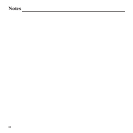
8180
For Your Safety
CAUTION: Changes or modifications not expressly
approved by the manufacturer could void the user’s
authority to operate the equipment.
NOTE: This equipment has been tested and found
to comply with the limits for a Class B digital device,
pursuant to part 15 of the FCC Rules. These limits are
designed to provide reasonable protection against
harmful interference in a residential installation. This
equipment generates, uses and can radiate radio
frequency energy and, if not installed and used in
accordance with the instructions, may cause harmful
interference to radio communications. However, there
is no guarantee that interference will not occur in a
particular installation. If this equipment does cause
harmful interference to radio or television reception,
which can be determined by turning the equipment
off and on, the user is encouraged to try to correct the
interference by one or more of the following measures:
• Reorient or relocate the receiving antenna.
• Increase the separation between the equipment and
receiver.
• Connect the equipment into an outlet on a
circuit different from that to which the receiver is
connected.
• Consult the dealer or an experienced radio/TV
technician for help.
For Your Safety
Radio Frequency (RF) Energy
This model phone meets the government’s requirements
for exposure to radio waves.
This phone is designed and manufactured not to exceed
the emission limits for exposure to radio frequency (RF)
energy set by the Federal Communications Commission
of the U.S. Government:
The exposure standard for wireless mobile phones
employs a unit of measurement known as the Specific
Absorption Rate, or SAR. The SAR limit set by the FCC is
1.6 W/kg.* Tests for SAR are conducted using standard
operating positions accepted by the FCC with the phone
transmitting at its highest certified power level in all
tested frequency bands. Although the SAR is determined
at the highest certified power level, the actual SAR level
of the phone while operating can be well below the
maximum value. This is because the phone is designed
to operate at multiple power levels so as to use only the
power required to reach the network. In general, the
closer you are to a wireless base station antenna, the
lower the power output.
The highest SAR values for this model phone as reported
to the FCC when tested for use at the ear and on the
body are:
Head: 0.56 W/kg, Body: 1.32 W/kg
(Body-worn measurements differ among phone models,
depending upon available enhancements and
FCC requirements.)
While there may be differences between the SAR levels
of various phones and at various positions, they all
meet the government requirement
The FCC has granted an Equipment Authorization for
this model phone with all reported SAR levels evaluated
as in compliance with the FCC RF exposure guidelines.
SAR information on this model phone is on file with the
FCC and can be found under the Display Grant section
of http://www.fcc.gov/oet/ea/fccid/ after searching
on FCC ID: SRQ-Z797C.
For body-worn operation, this phone has been tested
and meets the FCC RF exposure guidelines for use
with an accessory that contains no metal and positions
the handset a minimum of 0.59 inches (1.5 cm) from
the body. Use of other enhancements may not ensure
compliance with FCC RF exposure guidelines. If you do
not use a body-worn accessory and are not holding the
phone at the ear, position the handset a minimum of
0.59 inches (1.5 cm) from your body when the phone
is switched on.
* In the United States and Canada, the SAR limit for
mobile phones used by the public is 1.6 watts/kg
(W/kg) averaged over one gram of tissue. The standard
incorporates a substantial margin of safety to give
additional protection for the public and to account for
any variations in measurements.
FCC Compliance
This device complies with part 15 of the FCC Rules.
Operation is subject to the following two conditions:
(1) This device may not cause harmful interference, and
(2) this device must accept any interference received,
including interference that may cause undesired
operation.
Hearing Aid Compatibility
(HAC) Regulations for
Mobile Phones
In 2003, the FCC adopted rules to make digital
wireless telephones compatible with hearing aids and
cochlear implants. Although analog wireless phones
do not usually cause interference with hearing aids or
cochlear implants, digital wireless phones sometimes
do because of electromagnetic energy emitted by the
phone’s antenna, backlight, or other components. Your
phone is compliant with FCC HAC regulations (ANSI
C63.19- 2011). While some wireless phones are used
near some hearing devices (hearing aids and cochlear
implants), users may detect a buzzing, humming, or
whining noise. Some hearing devices are more immune
than others to this interference noise, and phones also
vary in the amount of interference they generate. The
wireless telephone industry has developed a rating
system for wireless phones to assist hearing device
users in finding phones that may be compatible with
their hearing devices. Not all phones have been rated.
Phones that are rated have the rating on their box or a
lable located on the box. Ratings are not guaranteed.
Results will vary, depending on the user’s hearing device
and hearing loss. If your hearing device happens to be
vulnerable to interference, you may not be able to use a
rated phone successfully. Trying out the phone with your
hearing device is the best way to evaluate it for your
personal needs.


















